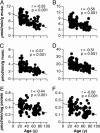Decline in skeletal muscle mitochondrial function with aging in humans
- PMID: 15800038
- PMCID: PMC556267
- DOI: 10.1073/pnas.0501559102
Decline in skeletal muscle mitochondrial function with aging in humans
Abstract
Cumulative mtDNA damage occurs in aging animals, and mtDNA mutations are reported to accelerate aging in mice. We determined whether aging results in increased DNA oxidative damage and reduced mtDNA abundance and mitochondrial function in skeletal muscle of human subjects. Studies performed in 146 healthy men and women aged 18-89 yr demonstrated that mtDNA and mRNA abundance and mitochondrial ATP production all declined with advancing age. Abundance of mtDNA was positively related to mitochondrial ATP production rate, which in turn, was closely associated with aerobic capacity and glucose tolerance. The content of several mitochondrial proteins was reduced in older muscles, whereas the level of the oxidative DNA lesion, 8-oxo-deoxyguanosine, was increased, supporting the oxidative damage theory of aging. These results demonstrate that age-related muscle mitochondrial dysfunction is related to reduced mtDNA and muscle functional changes that are common in the elderly.
Figures




References
-
- Herndon, L. A., Schmeissner, P. J., Dudaronek, J. M., Brown, P. A., Listner, K. M., Sakano, Y., Paupard, M. C., Hall, D. H. & Driscoll, M. (2002) Nature 419, 808–814. - PubMed
-
- Short, K. R. & Nair, K. S. (1999) J. Endocrinol. Invest. 22, 95–105. - PubMed
-
- Balagopal, P., Rooyackers, O. E., Adey, D. B., Ades, P. A. & Nair, K. S. (1997) Am. J. Physiol. 273, E790–E800. - PubMed
Publication types
MeSH terms
Substances
Grants and funding
LinkOut - more resources
Full Text Sources
Other Literature Sources
Medical

